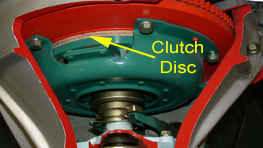Clutch Disc

Description: The clutch disc consists of a metal disc covered with a frictional facing similar to brake shoes or pads. The lining is made of a woven or molded non-organic material that also contains particles of soft metal such as aluminum or brass. This improves the strength of the lining and a series of radial grooves in the lining's face enhances the grip between the flywheel and the disc. A splined hub in the center of the disc mates with the transmission's input shaft, thereby providing a direct mechanical coupling between the two. A group of torsion springs located between the clutch hub and lining dampens driveline shock and vibration. The clutch disc is located between the flywheel and pressure plate.
Purpose: The clutch disc transmits engine torque directly to the input shaft of the transmission. The clutch disc, when coupled with the pressure plate and flywheel, makes and breaks the flow of power from the engine to the transmission.
Maintenance Tips/Suggestions: Since pressure to the clutch disc is applied and released continuously throughout the course of normal driving, the clutch disc lining will wear over time making it a normal wear item. Clutch chatter is a common symptom that may indicate a worn clutch, but this symptom could also be caused by oil leaking from the engine onto the clutch assembly, a poor flywheel surface, damaged pressure plate release levers, a sprung clutch disc hub and improper alignment between the engine and transmission. Another common clutch problem is clutch slippage. This can be caused by a variety of factors such as a damaged pressure plate, worn, binding or misadjusted linkage, incorrect clutch components, and even normal wear. A dragging clutch is the least common symptom and is just the opposite of slippage. Drag occurs when the clutch doesn't release at all, or releases only partially. Clutch drag is usually caused by a worn, binding or misadjusted clutch linkage. Drag can also be caused by air in the hydraulic clutch linkage, damaged pressure plate fingers, and binding of the clutch disc on the input shaft. To get to the heart of your car’s clutch problem, have Kirtec Auto Services road test your car to confirm the symptoms you’re experiencing. It’s the best first step of a proper diagnosis.

